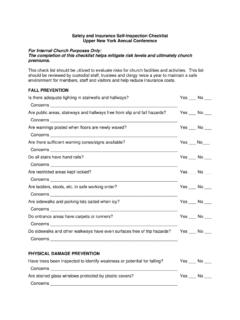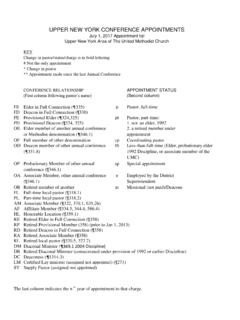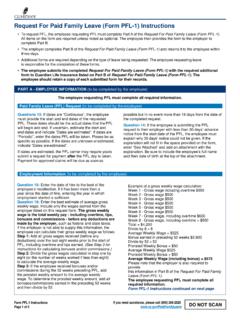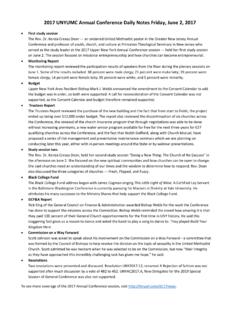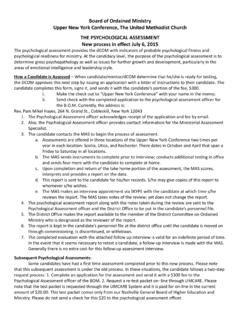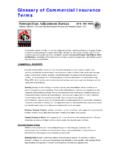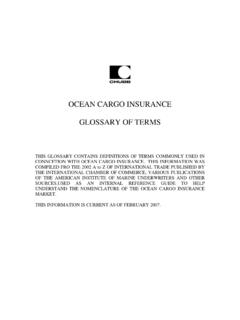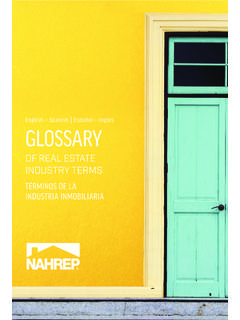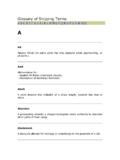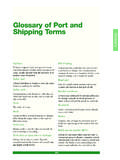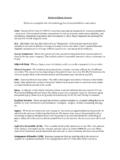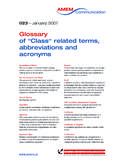Transcription of GLOSSARY OF INSURANCE TERMS - unyumc.org
1 GLOSSARY OF INSURANCE TERMS Replacement Cost A property INSURANCE term that refers to one of the two primary valuation methods for establishing the value of insured property for purposes of determining the amount the insurer will pay in the event of loss. (The other primary valuation method is actual cash value (ACV).) It is usually defined in the policy as the cost to replace the damaged property with materials of like kind and quality, without any deduction for depreciation. Modified Replacement Cost* The amount it would cost to repair or replace that part of the building that is damaged or destroyed with other property that is functionally equivalent to and less costly than the lost or damaged property. For example, we will use common construction materials and methods instead of obsolete, antique or custom construction materials or methods.
2 These include: (1) Lath and plaster interior finishes will be repaired and replaced with drywall. (2) Molded plastered areas will be eliminated. (3) Multiple floor coverings or floor structures will be repaired or replaced with only the floor covering in use at the time of loss. (4) Floor structural support will be limited to what is necessary to retain structural integrity. (5) Detailed or carved paneling or woodwork will be repaired or replaced with plain paneling or woodwork common to today's construction methods. (6) Antique or ornate fixtures and other amenities will be repaired or replaced with modern day fixtures and amenities. (7) Cut stonework or elaborate interior or exterior custom masonry or stonework will be repaired or replaced with common methods and materials used in modern construction.
3 All of the above are subject to the lower of either the repair cost of the damaged property or to replacement of the property with modern day materials and construction methods. Actual Cost Value In property one of several possible methods of establishing the value of insured property to determine the amount the insurer will pay in the event of loss. ACV is typically calculated as, the cost to repair or replace the damaged property, minus depreciation; Depreciation The decrease in the value of property over a period of time, usually as result of age, wear and tear from use, or economic obsolescence. Actual physical depreciation (wear and tear from use) is subtracted from the replacement cost of insured property in determining its actual cash value (ACV); Blanket Limit A single limit of INSURANCE that applies over more than one location or more than one category of property coverage, or both.
4 This is in contrast to specific or scheduled limits of INSURANCE , which are separate limits that apply to each type of property at each location. Example Church building of million, Education building at 500,000 and parsonage at 200,000 equals a blanket limit of million. The benefit of blanket coverage is that if one of the buildings suffers a covered major loss that for some reason costs more to repair than the individual insured value of that building, you have up to the entire blanket limit to draw from. Specific or Scheduled Limits Separate property INSURANCE limits that apply to each type of covered property interest (building, personal property, business income, etc.) at each covered location. Inland marine fine arts coverage Inland marine property INSURANCE for works of art, typically written on a valued basis.
5 Other categories include: musical instruments, jewelry, portable electronics, and trailers. Commercial General Liability A standard INSURANCE policy issued to business organizations to protect them against liability claims for bodily injury (BI) and property damage (PD) arising out of premises, operations, products, and completed operations; and advertising and personal injury (PI) liability. Umbrella A policy designed to provide protection against catastrophic losses. It generally is written over various primary liability policies, such as the business auto policy (BAP), commercial general liability (CGL) policy, watercraft and aircraft liability policies, and employers liability coverage. The umbrella policy serves three purposes: it provides excess limits when the limits of underlying liability policies are exhausted by the payment of claims; it drops down and picks up where the underlying policy leaves off when the aggregate limit of the underlying policy in question is exhausted by the payment of claims; and it provides protection against some claims not covered by the underlying policies, subject to the assumption by the named insured of a self insured retention (SIR).
6 Coinsurance A property INSURANCE provision that penalizes the insured's loss recovery if the limit of INSURANCE purchased by the insured is not equal to or greater than a specified percentage (commonly 80 percent) of the value of the insured property. The coinsurance provision specifies that the insured will recover no more than the following: the amount of the loss multiplied by the ratio of the amount of INSURANCE purchased (the limit of INSURANCE ) to the amount of INSURANCE required (the value of the property on the date of loss multiplied by the coinsurance percentage), less the deductible. The amount of the loss that is not payable to the insured as a result of failure to comply with the coinsurance provision is commonly referred to as a coinsurance penalty.
7 Coinsurance percentages commonly are 100%, 90% and 80%. Example The conference selected Blanket Replacement Cost coverage at 90% Coinsurance. If there are 3 buildings, (Church 1,000,000 Replacement value, Education Building 1,000,000 Replacement Value and Parsonage $500,000 Replacement Value) the total Replacement Value is $2,500,000. The INSURANCE contract requires a minimum limit of coverage of 90% or $2,250,000. INSURANCE to value INSURANCE written in an amount approximating the value of the subject of INSURANCE or that meets coinsurance requirements. All definitions except the one noted with the * taken from the online INSURANCE GLOSSARY at the website *definition comes from the Church Mutual INSURANCE contract form A113 (5 89) and does not include all conditions or requirements of the endorsement.
8 For questions contact Andy Ryan at Church Mutual INSURANCE Company by calling (800) 554 2642.
